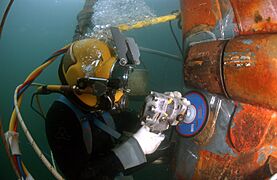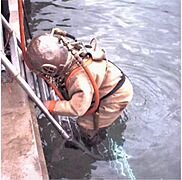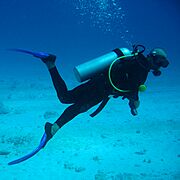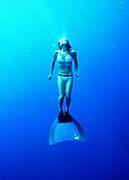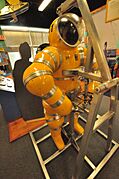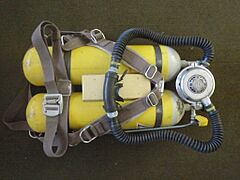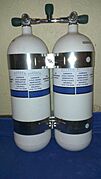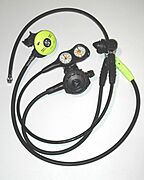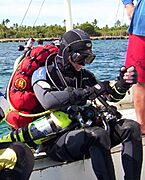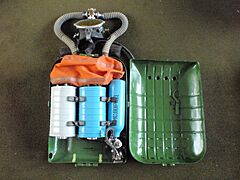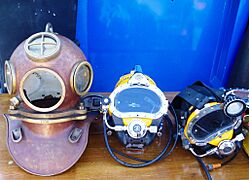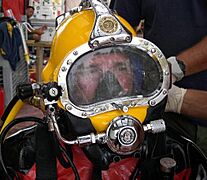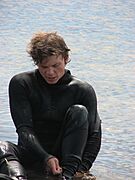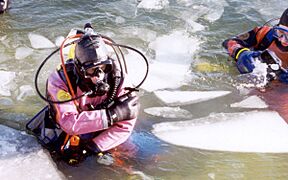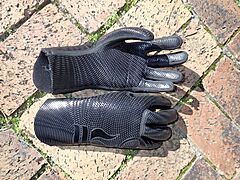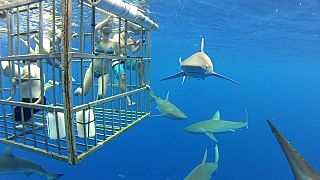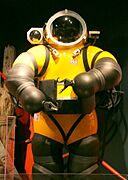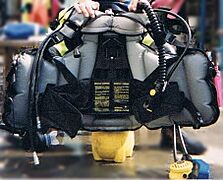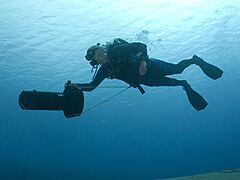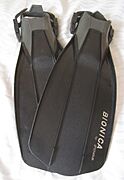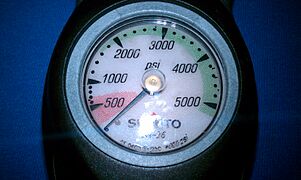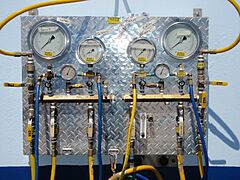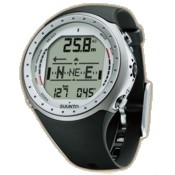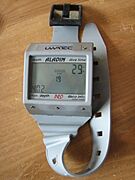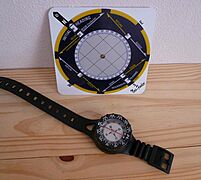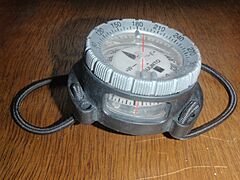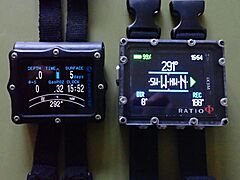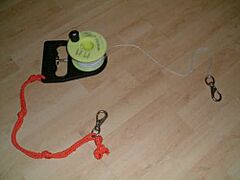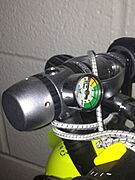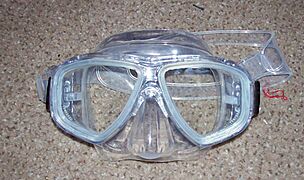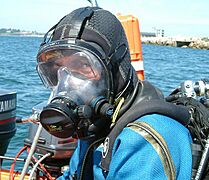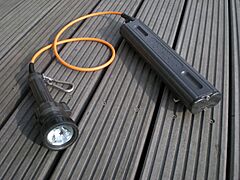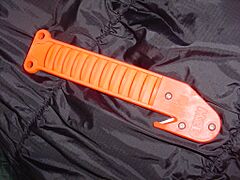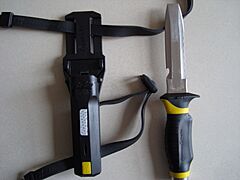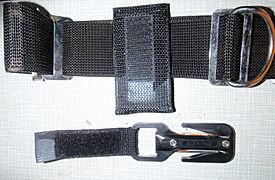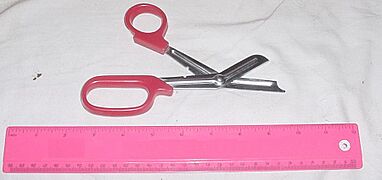Diving equipment facts for kids
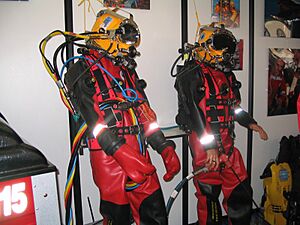
Surface supplied commercial diving equipment on display at a trade show
|
|
| Other names | Dive gear |
|---|---|
| Uses | Facilitate underwater diving operations |
Diving equipment, also called dive gear, is special gear used by divers to explore underwater. This equipment helps divers stay safe, comfortable, and makes it easier to do things underwater.
The most important part of diving equipment is the underwater breathing apparatus. This includes scuba gear and surface-supplied diving equipment. Other important items make diving safer and more fun. Scuba divers usually carry their own gear. However, professional divers, especially those who stay underwater for a long time, use a lot of support equipment that stays on the surface.
Contents
Types of Underwater Breathing Gear
Divers use different types of breathing gear depending on how they dive.
Surface-Supplied Diving
This is mostly used by professional divers. Air comes from the surface through a hose.
- Bounce diving means the diver goes down and comes back up to the surface.
- Saturation diving means divers live under pressure in special underwater homes or chambers. They stay there for many days or weeks.
- Standard diving dress is an old type of heavy diving suit. It is mostly for history now.
- Airline or Hookah diving uses a simple hose from the surface.
- Snuba is a fun, light version of surface-supplied diving for recreation.
Scuba Diving
This uses self-contained underwater breathing gear. Divers carry their air with them.
- Open-circuit scuba uses tanks of air and regulators. The diver breathes in, and the used air bubbles out.
- Rebreather diving uses special gear that recycles the air. This means fewer bubbles and longer dives.
Free Diving
In free diving, divers hold their breath. They do not use any breathing equipment underwater.
- A snorkel lets you breathe at the surface while your face is in the water. It is used with free diving and scuba.
Special Diving Suits
- Atmospheric diving suits are like small submarines that a diver wears. They keep the diver completely dry and at normal air pressure.
Personal Diving Equipment
This is the gear divers wear or carry. It helps them stay safe, comfortable, and move around underwater.
Underwater Breathing Gear
- Scuba equipment: This includes the main air tanks (carried on the back or side) and regulators. Divers also carry extra air tanks, called bailout bottles or pony bottles, for emergencies. Sometimes a full-face diving mask is used.
- Surface-supplied equipment: This includes a helmet or full face mask, a hose (umbilical) from the surface, and an emergency air tank.
-
A diver using a closed circuit rebreather.
Protection from the Environment
Divers need protection from cold water, stings, and scrapes.
- In cold water, a diving suit is needed. This can be a dry suit (for very cold water, 0-10°C) or a wet suit (for warmer water, 21-25°C). Professional divers might use a Hot water suit that gets warm water from the surface.
- Overalls are often worn over diving suits to protect them from damage.
- In very warm water (26-30°C), divers might wear thin suits like dive skins or just swimsuits.
- Diving gloves protect hands.
- Diving suit hoods keep the head warm and offer some protection.
- Diving boots are worn with dry suits or wet suits.
- A Safety helmet can protect the head while scuba diving.
- Diving chain mail can protect against bites from large marine animals.
- Diver's cages offer protection from large predators.
- Atmospheric diving suits completely separate the diver from the water.
Staying Stable and Moving Underwater
This equipment helps divers control their position and move through the water.
- Buoyancy control means managing how much you float or sink. Divers use weights to help them sink.
- A Buoyancy compensator (BC or BCD) is a jacket-like device that can be inflated with air. This helps divers control their buoyancy underwater and float at the surface.
- Diver Propulsion Vehicles (DPVs) are like underwater scooters. They help divers travel faster and further.
- Fins are worn on the feet to help divers swim efficiently.
This equipment helps divers know where they are, how deep they are, and how much air they have.
- A Depth gauge shows how deep the diver is.
- A Diving watch or dive timer tracks how long the diver has been underwater.
- A Diving compass helps divers navigate underwater.
- A Submersible pressure gauge (SPG) shows how much air is left in the tank.
- A Dive computer is a smart device that helps divers avoid decompression sickness. It shows depth, time, and how fast to come up. Some also show air pressure.
- A Distance line or cave line is a rope divers use to find their way back, especially in caves or bad visibility.
-
A depth gauge and submersible pressure gauge.
Vision and Communication
Seeing and talking underwater can be tricky. Special gear helps.
- Masks help divers see clearly underwater.
- Full face masks cover the eyes, nose, and mouth. They can also have built-in communication systems.
- Half masks cover only the eyes and nose.
- Prescription masks have special lenses for divers who wear glasses.
- Diving helmets are often used for surface-supplied diving. They protect the head and allow for communication.
- Underwater writing slates and pencils let divers write messages to each other.
- Dive lights are waterproof flashlights. They are important for seeing in dark places like wrecks or at night. They also help show true colors underwater.
Safety Equipment
This gear is specifically designed to make dives safer.
- A Diver's safety harness can have a rope (lifeline) attached to a person on the surface.
- A Shotline is a weighted rope with a buoy. It marks the dive site and helps divers go up and down safely.
- A Buddy line is a short rope connecting two divers. It keeps them together in bad visibility.
- A Surface marker buoy (SMB) or decompression buoy (DSMB) is a float that divers send to the surface. It shows where they are to people on boats.
- Cutting tools like a Knife or line cutter help divers get free if they get tangled in fishing lines or nets.
Surface Detection Aids
These items help people on the surface find divers.
- Surface marker buoys or safety sausages are bright floats.
- A flag (red or yellow) warns boats that divers are nearby.
- A Whistle or high pressure whistle can be used to call for help.
- A Torch or flashlight or Strobe light is used at night.
- Orange dye marker makes divers easier to spot from a helicopter.
- A Mirror can reflect sunlight to signal.
- Flares are used for emergencies to signal boats or helicopters.
- Emergency locator beacons send a GPS signal to rescuers.
- Glow sticks are used for night diving.
Personal Tools and Accessories
- Cameras and video lights are used for underwater photography and videography.
- A Diving reel or spool holds a long line. This line can be used with a surface marker buoy or for navigation.
- A Dry box keeps small items like a wallet dry underwater.
- A Dry bag keeps things dry on the boat.
- A tool bag carries tools needed for underwater work.
- A rescue tether is a short strap used by a rescue diver to connect to another diver in an emergency.
Diving Team Tools and Equipment
These are larger tools used by a diving team.
- A jackstay is a guide rope laid between two points. It helps divers search or move equipment.
- Lifting bags are strong bags filled with air underwater to lift heavy objects.
- A shot line is a weighted line with a buoy. It marks a dive site and helps divers go up and down.
- A Decompression trapeze is a bar or frame underwater. Divers hold onto it during decompression stops to stay at the correct depth.
- Diving bells and diving stages are used to carry divers from the surface to their underwater work area.
- A downline is a rope from the surface to the underwater work site. It helps divers control their descent and ascent, and move tools.
Surface Support Equipment
This equipment stays on the surface but helps with diving operations.
- Boarding ladders help divers get back onto the boat, even with fins on.
- Dive platforms on boats make it easier to enter and exit the water.
- A Diver down flag is flown to warn other boats that divers are in the water.
- Diving air compressors fill diving tanks with air.
- Diving chambers are special rooms used for surface decompression or to treat diving sickness.
- Diving support vessels are boats that help with diving operations. This includes dive boats and larger vessels.
- GPS receivers help locate dive sites.
- Surface-supplied diving systems include:
- Air compressors for breathing air.
- Gas panels to control air flow to divers.
- Diver's umbilicals (hoses) that carry air and communication lines.
- Diver voice communication equipment.
- Hot water systems provide warm water for divers wearing hot water suits.
- Marine VHF radios are used to talk to rescue services and other boats.
- Saturation systems provide support for divers living underwater for long periods.
Maintenance and Testing
Diving equipment, especially life support gear, must be checked and cared for regularly. This makes sure it is safe to use. Before every dive, divers check their equipment. This is very important for safety. If equipment is not checked, it can be dangerous.
After diving, equipment should be cleaned, especially from salt water. Salt can damage gear. Sunlight and ozone can also harm some parts. Most diving gear lasts longer if stored in a cool, dry place away from direct sunlight.
Cleaning and Disinfection
Diving equipment can get dirty or contaminated. If divers share equipment, it must be cleaned and disinfected. This is especially true for masks, helmets, and snorkels, which touch the face or mouth. Disinfection helps stop the spread of germs. It is important to use cleaners that do not damage the equipment.
The Diving Industry
The diving equipment market has different parts: professional diving, military diving, recreational scuba, free diving, and snorkeling. Scientific diving uses a mix of these types of gear.
The professional diving market is small, but it needs very reliable and safe equipment. This is because the work is often dangerous and important, like in the oil and gas industry. The military market is also small and often uses similar gear to professional diving.
Recreational scuba and snorkeling are the biggest markets. Many companies compete to sell gear to people who dive for fun.
History of Diving Gear
The way people dive has changed a lot over time. This is because new technology has been invented. This technology helps divers deal with the challenges of being underwater.
DEMA
| Abbreviation | DEMA |
|---|---|
| Formation | 1987 |
| Type | Trade Association |
| Legal status | Mutual-benefit nonprofit corporation Incorporated in California, |
| Purpose | Advocacy for the recreational diving industry |
| Headquarters | California, United States of America |
|
Membership
|
1,300 |
|
Formerly called
|
Diving Equipment Manufacturers Association |
DEMA stands for the Diving Equipment and Marketing Association. It is a group that helps the recreational scuba diving and snorkeling industries grow. It is a non-profit group with over 1,300 members worldwide. DEMA works to encourage more people to dive and helps businesses in the diving industry. They also have a big yearly trade show.


